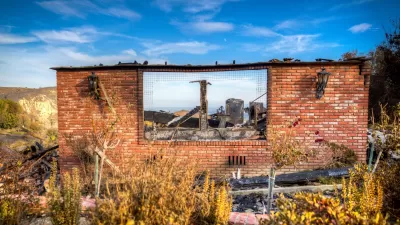A new report says that the state is going to face huge challenges in building 3.5 million homes over the next seven years.

California Governor Gavin Newsom wants to build 3.5 million new homes by 2025 to tackle the state's housing shortage. But a forthcoming report from the UCLA Luskin School of Public Affairs says that only 2.8 million homes can be built on the available land zoned for housing, and the problems do not end there, reports Liam Dillon:
Because not all that land can be developed quickly for home construction, the state would probably have to double or triple the amount of land zoned for housing for the governor to reach his goal, said Paavo Monkkonen, an associate professor of urban planning and public policy at UCLA.
Newsom’s homebuilding plan also seeks to address climate change by building near transit and job centers to cut down on auto use. But land in San Bernardino, Madera, and Kern counties is in unincorporated areas, notes Dillion. "To meet goals for housing production, climate change and providing access to existing jobs, communities will have to dramatically reorient how they zone land for housing away from rural neighborhoods and toward urban centers, Monkkonen said."
FULL STORY: California doesn't have enough land set aside to meet Gov. Gavin Newsom's housing goals, report says

Study: Maui’s Plan to Convert Vacation Rentals to Long-Term Housing Could Cause Nearly $1 Billion Economic Loss
The plan would reduce visitor accommodation by 25,% resulting in 1,900 jobs lost.

North Texas Transit Leaders Tout Benefits of TOD for Growing Region
At a summit focused on transit-oriented development, policymakers discussed how North Texas’ expanded light rail system can serve as a tool for economic growth.

Why Should We Subsidize Public Transportation?
Many public transit agencies face financial stress due to rising costs, declining fare revenue, and declining subsidies. Transit advocates must provide a strong business case for increasing public transit funding.

How to Make US Trains Faster
Changes to boarding platforms and a switch to electric trains could improve U.S. passenger rail service without the added cost of high-speed rail.

Columbia’s Revitalized ‘Loop’ Is a Hub for Local Entrepreneurs
A focus on small businesses is helping a commercial corridor in Columbia, Missouri thrive.

Invasive Insect Threatens Minnesota’s Ash Forests
The Emerald Ash Borer is a rapidly spreading invasive pest threatening Minnesota’s ash trees, and homeowners are encouraged to plant diverse replacement species, avoid moving ash firewood, and monitor for signs of infestation.
Urban Design for Planners 1: Software Tools
This six-course series explores essential urban design concepts using open source software and equips planners with the tools they need to participate fully in the urban design process.
Planning for Universal Design
Learn the tools for implementing Universal Design in planning regulations.
City of Santa Clarita
Ascent Environmental
Institute for Housing and Urban Development Studies (IHS)
City of Grandview
Harvard GSD Executive Education
Toledo-Lucas County Plan Commissions
Salt Lake City
NYU Wagner Graduate School of Public Service





























